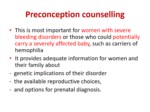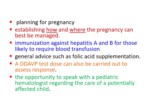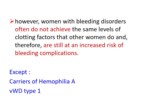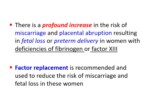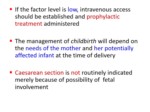بخشی از پاورپوینت
اسلاید 1 :
Preconception counselling
- This is most important for women with severe bleeding disorders or those who could potentially carry a severely affected baby, such as carriers of hemophilia
- It provides adequate information for women and their family about
- genetic implications of their disorder
- the available reproductive choices,
- and options for prenatal diagnosis.
اسلاید 2 :
- planning for pregnancy
- establishing how and where the pregnancy can best be managed.
- immunization against hepatitis A and B for those likely to require blood transfusion
- general advice such as folic acid supplementation.
- A DDAVP test dose can also be carried out to assess response.
- the opportunity to speak with a pediatric hematologist regarding the care of a potentially affected child.
اسلاید 3 :
Antenatal management
Normal pregnancy is accompanied by
- Increased concentrations of several coagulation factors including VIII, VWF, and a pronounced increase in fibrinogen
- reduced fibrinolytic activity secondary to increased levels of plasminogen activator inhibitors, especially during the third trimester
- All of these changes contribute to the hypercoagulable state of pregnancy and, in women with bleeding disorders, to improved hemostasis
اسلاید 4 :
Øhowever, women with bleeding disorders often do not achieve the same levels of clotting factors that other women do and, therefore, are still at an increased risk of bleeding complications.
Except :
Carriers of Hemophilia A
vWD type 1
اسلاید 5 :
- Baseline factor VIII and von Willebrand factor levels should be checked at some stage early in the pregnancy, such as during the first consultation with an obstetrician and in the third trimester (ideally at around 34 weeks).
- The level of vWF may not rise significantly during the first or even second trimester and therefore an early miscarriage may be accompanied by significant bleeding
اسلاید 6 :
- There is a profound increase in the risk of miscarriage and placental abruption resulting in fetal loss or preterm delivery in women with deficiencies of fibrinogen or factor XIII
- Factor replacement is recommended and used to reduce the risk of miscarriage and fetal loss in these women
اسلاید 7 :
Øin women with other bleeding disorders is less clear the risk of:
- miscarriage,
- antepartum bleeding,
- and adverse outcome
ØAlso consider obstetric causes as a reason for bleeding
اسلاید 8 :
labour and delivery
- There is no consensus on the factor levels that are safe for regional anesthesia,
- but if levels are at least 50% and the rest of the coagulation studies are normal, regional anesthesia may be considered safe.
- It is often difficult to obtain factor levels during labour and is therefore acceptable to use third trimester levels to formulate an appropriate plan.
اسلاید 9 :
- If the factor level is low, intravenous access should be established and prophylactic treatment administered
- The management of childbirth will depend on the needs of the mother and her potentially affected infant at the time of delivery
- Caesarean section is not routinely indicated merely because of possibility of fetal involvement
اسلاید 10 :
DDAVP
- may be used to raise factor VIII and vWF levels in carriers of hemophilia A and type I VWD prior to invasive procedures.
- It is generally thought to be safe for mother and fetus, but care must be taken in its administration at the time of childbirth.
- At the time of childbirth, administration of DDAVP, combined with fluids and oxytocin, may result in life-threatening hyponatremia. Therefore, fluid balance and electrolyte levels should be strictly monitored.



